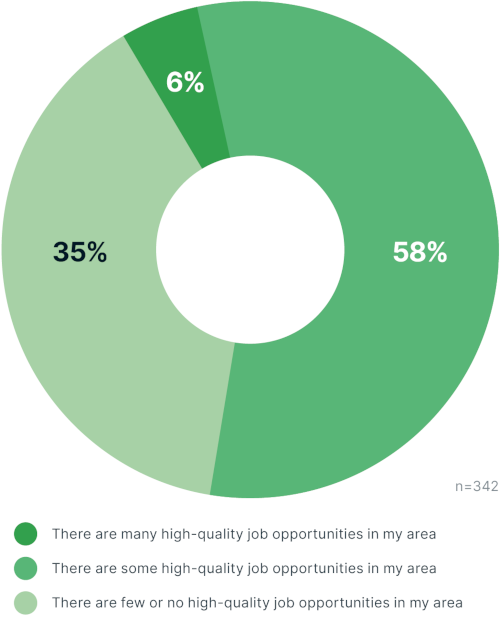Rural America Is Ready for Remote Work
Download Report
In the remote work debate, one group is rarely considered
In our noisy debates about remote work, a big segment of the population is being overlooked—rural Americans. Their concerns are not the cultural issues that dominate the big city discussion: things like what are the trade-offs between flexibility, productivity and culture within a business? For rural Americans remote work is about something more fundamental—the opportunity for access, access to a job market that otherwise seems set to leave people already left behind even further behind.
And a significant segment of the labor force faces big challenges. Midcareer and older workers are a growing portion of the labor force, but they are more likely to struggle with long-term unemployment.
To learn more, we recently commissioned YouGov to survey more than 500 individuals aged 45 or older who reside in rural areas across 17 states that make up the Appalachia and Delta regions.
The precarious finances of rural midcareer and older workers in the US
Economic uncertainty can fuel anxiety and despair, and rural Americans continue to face more than their share of it. Historically, median household income in rural America has been about 25% lower than in urban areas1. While that gap has narrowed over time, individuals in rural areas on average are older, more likely to be out of the workforce, and make lower incomes2.
As a result, financial insecurity is a way of life. Sixty-one percent of the individuals aged 45+ whom we surveyed say they would not be able to cover an unexpected expense of $1,000. In fact, 37% do not have enough money to cover their daily needs, and another 32% are just making ends meet.
Rural midcareer Americans struggle to make ends meet

Diagnosing rural America’s good jobs gap
Job creation persists in non-urban regions, though at a slower pace. Indeed, 53% of our respondents agree there are some jobs where they live. But only 15% say there are many opportunities. And among those who say opportunities exist, only 6% say there are many high-quality jobs in their area, while a third (35%) say there are no or few high-quality job opportunities.
For our respondents, to be clear, high-quality is not about the degree of, say, technical skill or educational credentials required. They mean something more basic and tied directly to their financial struggle: 83% of respondents said that a high-quality job is one that offers a competitive salary, 72% pointed to security (72%), and 71% said it should provide full-time hours.
And moving isn’t an easy solution: Only 24% of respondents consider relocation an even “somewhat likely” option, and a mere 8% of respondents say they are “very likely” to relocate for better jobs. They cite cost, caregiving responsibilities, and community ties as the most important reasons.
Rural areas suffer from a shortage of high-quality jobs

The case for remote work for midcareer and older job seekers in rural areas
Barring an unlikely surge in direct investment or outward migration, how else can the US hope to deal with persistent unemployment and under-employment among midcareer and older workers in rural America? Our survey points to an expansion in remote work as a real option.
Among the multiple factors any company would need to consider before making such an investment, we focused on one key variable: the willingness of the local workforce to try something new.
Even though 71% of all respondents have not participated in any formal job training or skills development programs in the last three years, 50% told us they are interested or very interested in learning new skills to advance their careers. And even more – 75% – say they would take courses or learn new skills to make themselves more competitive for remote opportunities.
Both employed and unemployed individuals expressed high interest in learning new skills, especially for remote job roles

Conclusion
One in five Americans live in rural areas, and many are hurting. If we care about the well-being of these individuals, families, and communities, then we need to find new ways to help improve their situation.
Creating more remote jobs represents one such opportunity. And it’s an opportunity that doesn’t require some grand new policy program. As our survey confirms, there is a clear appetite among rural workers to gain the skills needed to take advantage of such jobs.
To seize this potential opportunity, employers, training providers, and government all have a role to play.
At the moment the backlash against remote work is spurring a decline in such jobs3. Our survey confirms that, if we care about creating more opportunities and access to jobs for rural Americans, it’s time to reverse that trend.
Download ReportReferences:
- Economic Research Service, USDA 2017 ↩︎
- FHFA blog, “Who Lives in Rural America?”, Dec 2024 ↩︎
- LinkedIn, “Remote Work Continues to Decline”, 2025 ↩︎